It's Monday
Chris: Hey, Ellen! It’s Monday, Day 4 of our 2019 Spring Trials journey and we haven’t killed each other yet. On top of that, I had a steak sandwich for lunch AND for dinner. I’d call that a good day.
Ellen: It was a good day! The only dark spot was the salty fried pickles this evening. Let’s hope it doesn’t turn me off the delicacy forever. Oh, and it was a productive stop day, too—four stops, seven companies, lots of pretty flowers.
Chris: Now that we’ve gotten the food talk out of the way (our fans expect at least a little culinary banter), we can recap our day around Salinas, California, where we hit Sakata, Takii, Floricultura and Speedling. Not a lot of driving, which means we could spend our time looking at flowers rather than looking at the windshield.
Ellen: And veggies. Don’t forget the veggies, Chris. Speaking of which, Sakata introduced a bunch of them, per usual. How about as a way to dive into today’s highlights, you take their new flower intros and I’ll take the new veggies. Deal?

Sakata's Flowers
Chris: Deal. You’re the better vegetable gardener anyway.
Okay, flowers from Sakata: First up is a new begonia series called Viking. It’s an oversized benariensis type that competes with Whopper, Big and Top Hat. One advantage it may possess is that it offers three foliage colors—green, bronze and chocolate—and several colors, including Pink, Rose and Red. Oh, and two sizes: Viking and Viking XL, just in case the regular Viking isn’t big enough.
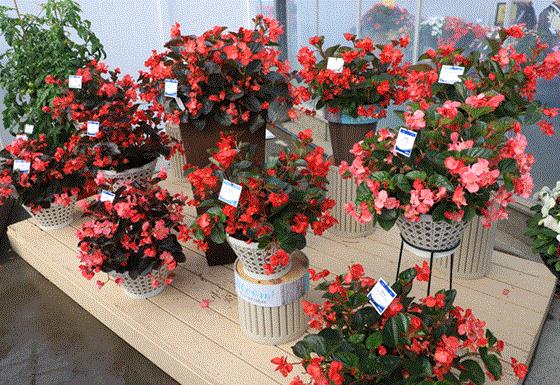
SunPatiens gets four new colors: Vigorous Orange, Vigorous Tropical Orange (“Tropical” means it’s variegated), Vigorous Lavendar Splash and, most importantly, Compact Orchid Blush (that’s it in the back right of the photo below). This one is important because it's been bred for improved drought tolerance. We asked how this was possible and were told that they’ve added the blood of an impatiens from Indonesia that has a drought-resistant trait. They’ll eventually work that trait into the whole series. We’ll have to try it to find out, but it sounds good.
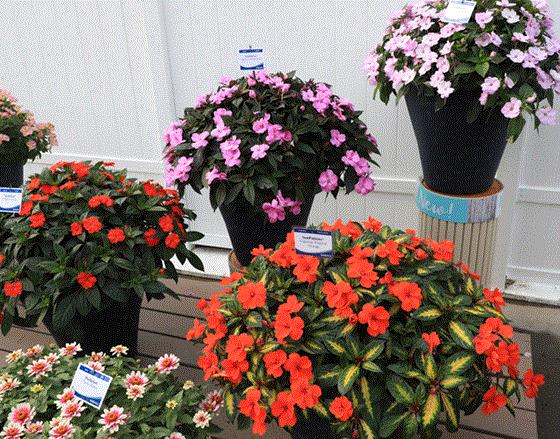
Lastly, I’ll mention Zinnia Profusion Cherry Bicolor, the first bicolor in the award-winning Profusion line. It has an interesting characteristic—it starts out light in color and darkens as it ages rather than fades.
So, Ellen, what’s new in Sakata veggies?

Sakata's Veggies
Ellen: Sakata has a ton of veggies in their commercial farmer arsenal to pull from for their consumer intros. In fact, all of the new veg they showed us today would be equally at home in a small-market grower’s field. For example? Eclipse Watermelon. It’s an icebox-sized, seedless variety. Of course, because it’s seedless, you’ll need to plant it with a seeded watermelon that will help with pollination (they suggest Wild Card Plus). Eclipse has a lovely bright red flesh that Sakata’s resident watermelon expert Tracy Lee calls her “absolute favorite”-tasting watermelon.
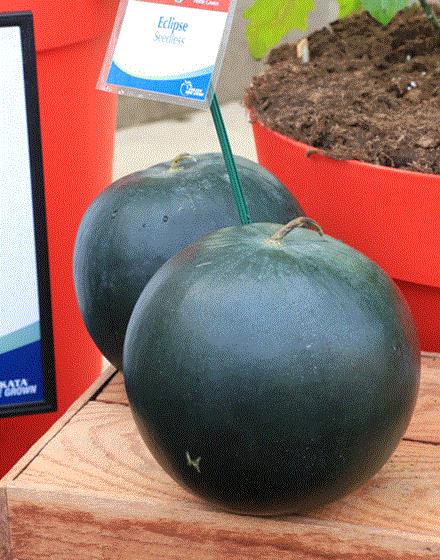
Tomatoes are important for market growers and consumers alike. They introduced four: Invincible, an indeterminate saladette with late blight resistance; Cedro, a compact indeterminate saladette hitting just 5-ft. tall; Carmesin, a determinate grape tomato (good for market growers because being determinate means less crop and plant maintenance); and Roadster, a determinate salad tomato that’s ready for harvest in a relatively fast 65 to 70 days.
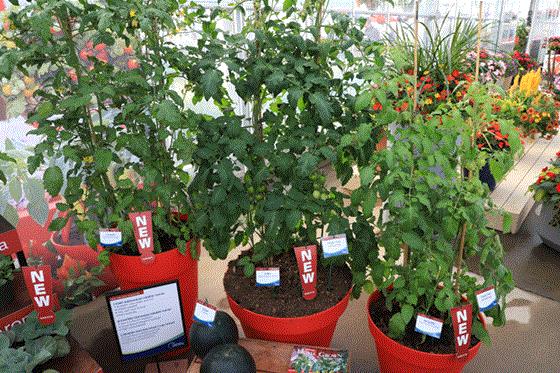
Last, a new jalapeño. It’s one of my favorite pepper crops to grow, but they can get rangy and tip over. Sakata solves that with Early Flame, which has a compact habit. Good for containers, Early Flame sets heavily in a short time and matures to spicy red peppers in about 60 to 65 days. Great for making sriracha!
For all these and more from Sakata (including Chris in a viking hat), check out our video HERE.

Takii
Chris: Across highway 101 we find Takii (where I had a fabulous tri-tip sandwich) and were introduced to their brand-new zinnia series, Preciosa. It’s an F1 seed series that grows to about 12 in. to 18 in., depending upon where you’re gardening. They compare it to the Magellan series. Preciosa has seven colors and two mixes, plus Orange (which only comes in their Tropical Blend mix, but will eventually be separated out).
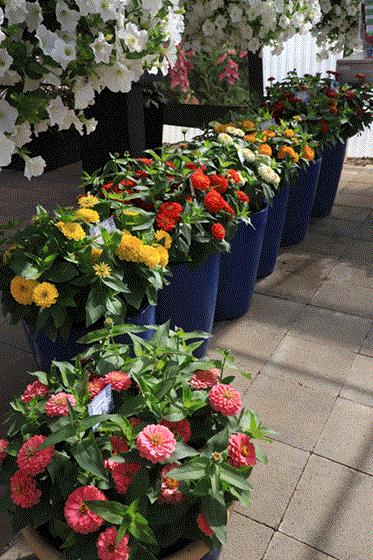
Ellen: Maybe it’s because I grew up in the ’70s, but there’s something about their new Pink Panther Digitalis I really liked. It’s a beautiful pink and planted en masse in the middle of Takii’s trial greenhouse it was lovely. What’s also loveable is the fact it’s first-year flowering (needing no vernalization), has branching that encourages multiple flowers and can overwinter down to Zone 6. Where’d it come from? Sahin breeding.
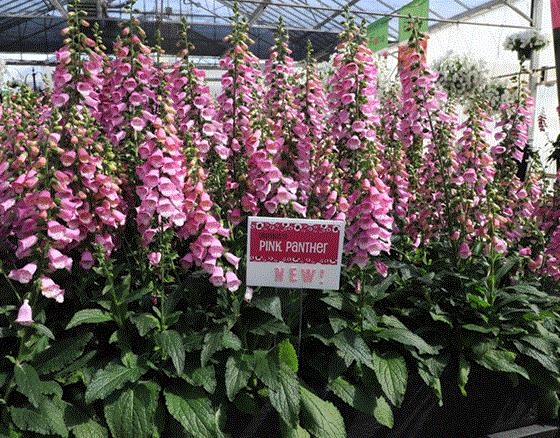
Chris: I remember that. Takii bought Sahin back in 2007. Fascinating they’re still bringing out varieties from that breeding program!
Lastly at Takii is breeding company HilverdaKooij, which borrows some greenhouse space from them. We mentioned this Dutch breeder in our Sunday email in connection with their new merger with gerbera breeder Florist. HilverdaKooij showed one interesting introduction: a salvia that’s ... well ... big! It’s an interspecific hybrid, said to be hardy to Zone 7 or so—about like Salvia Black & Blue. This salvia—as yet unnamed, it’s so new—comes in several nice colors, including a very striking orange and magenta. It’s extremely vigorous—they had one specimen plant a year old grown from just two plants.
If you want to see all that and more from Takii, click HERE for our video.

At Floricultura
Ellen: From Takii, we headed south a few miles to giant orchid producer Floricultura, who played host to Beekenkamp and Monrovia. I was reminded how much I like kalanchoes while going through Beekenkamp’s exhibit. They’ve recently partnered with Dutch kalanchoe breeder and producer SlijkermanKalanchoë on production and distribution of kalanchoes for the North American market, and hence had a big display of them. They showed just a portion of Slijkerman’s 25-or-so years of kalanchoe breeding. Their main series is called Diamonds, with flowers offered in both single and double form—the bright red Lipstick being the most popular of the bunch. A new series is the all-double Serenity, whose uniformity across 15 colors is due to the fact that they’re all mutations from one plant. That was a looker of a series, Chris!
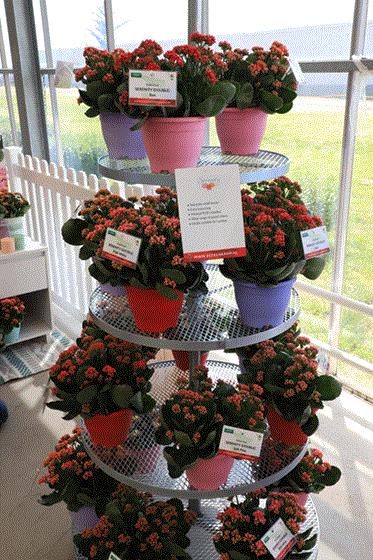
Chris: Sure was! Kalanchoes fit well with their other potted crop, begonias.
You mentioned Monrovia, the other Trial participant at Floricultura. Monrovia offers loads of exclusives in woodies and patio plants. What they were most emphasizing, however, was last year’s pre-introduction, SunBelievable Sunflower (helianthus). They’ve got plenty available for anyone who wants to grow or retail them. SunBelievable’s claim to fame is flower power—a claimed 1,000 flowers per plant. They have to be in a Monrovia-branded pot, but if you don’t like the standard one, they have a new decorator pot with an embossed 3D logo in the side—a classy way to brand a plant.
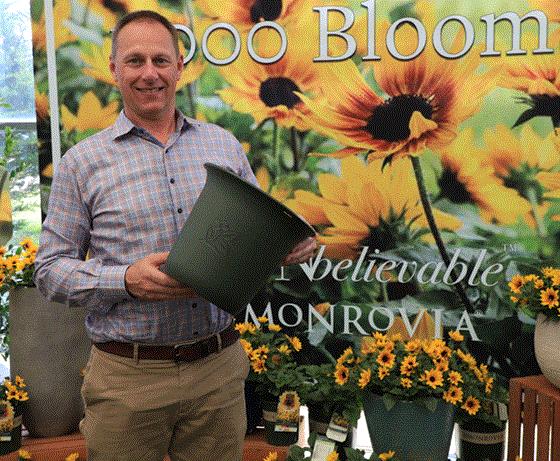
Okay, Ellen, take us up highway 101 to Speedling.

Hem & Vista
Ellen: Will do! Per usual, Hem Genetics was the anchor for the exhibitors at Speedling. Known for low-PGR-centric workhorses of the flower garden, I’ll instead start with some of their recent tomato breeding: Plumbrella’s a 14- to 16-in. cherry-type tomato in four colors with lots of fruit and Funnyplums are even shorter at 10 to 12 in. in three good colors. Oh, and Plumbrella comes in a mix! Multiple tomato colors in one pot? Awesome!
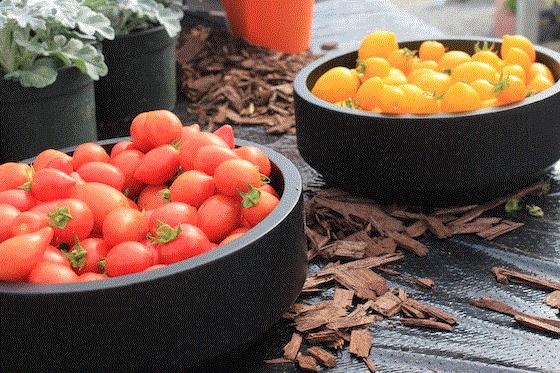
Chris: Alas, that all-to-common sob story of Spring Trials—plants that got mangled somewhere along the line—affected Hem’s tomatoes, so we didn’t get to see the actual plants. But they had lots of the fruits and they were delicious!
Okay, as for Hem’s flowers, they didn’t have any new series to offer, just color additions to series. Such as: Viola Corina Purple Ice, Dianthus Supra Scarlet and Dianthus Diana Loving White (below)—which was interesting in that it’s mostly varying shades of pink and lavender, with not very much white in the variety.
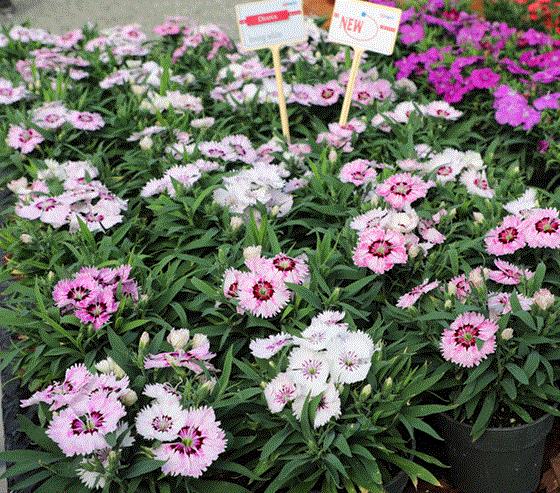
Ellen: Next up was Vista Farms, the Puerto Rican bougainvillea producer. Hurricane Maria hit the island hard in September 2017, but they recovered quickly—and recovered so well, in fact, that they increased sales by more than 20% ... not one year, but two years in a row!
News from Vista is that they finally have Bougainvillea Vera White in their stable, joining the rest of the Vera colors from Dutch breeder RijnPlant. White is always an important color addition, even in a flower that most folks think comes in only one color: bright pink.
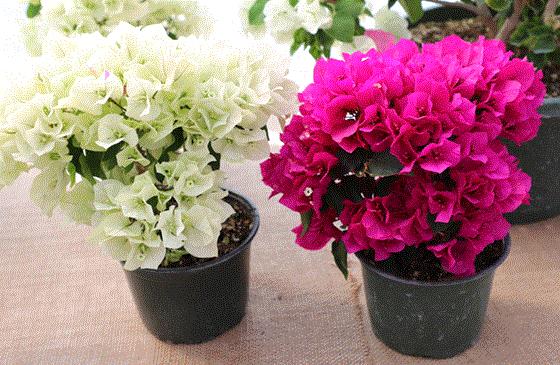

Where to Next?
Chris: The other Vista news is that they’re now producing cuttings of the J. Berry Hollywood Hibiscus. So now you can get two hot-selling tropicals from one source.
Well, Ellen, that’s Day 4 in a nutshell. And speaking of nuts, be sure to click on all our video links above. “Like” them and hit the subscribe button so you never miss another.
Ellen: And don’t forget, Chris—and all of you out there —that videographer extraordinaire Jen Zurko has been creating additional videos all week long. She has two additional videos that you can find here:
Kieft
Morel
So where next, boss?
Chris: Tuesday, Day 5, will feature Syngenta, Proven Winners and Danziger—a big day! I suspect the writing up of the highlights will tax our storytelling powers to the utmost. We’d best rest up!
Chris and Ellen


Chris Beytes
Editor & Publisher
GrowerTalks and Green Profit
Ellen Wells
Editor-at-Large
Green Profit
This email received by 29,116 lucky folks, and you're one of them!
Want to be one of the lucky sponsors who reach those 29,116 readers of Acres of Buzz from Spring Trials? Drop Paul Black a line and he'll tell you what a bargain it is!